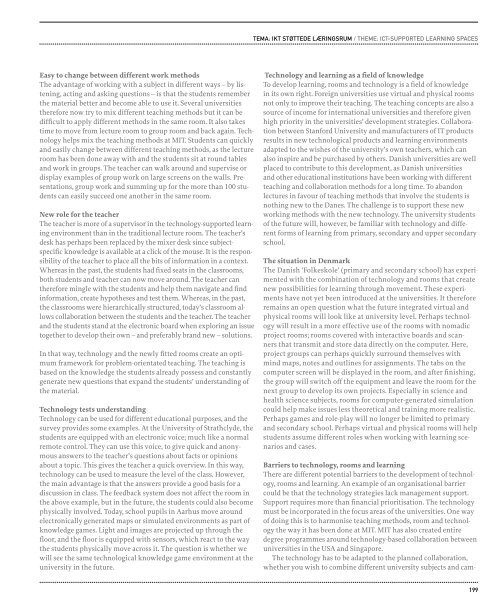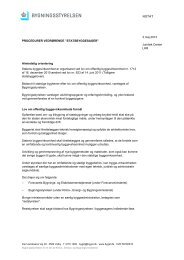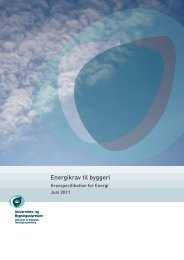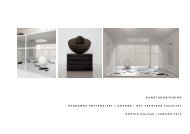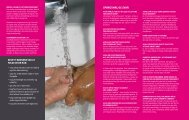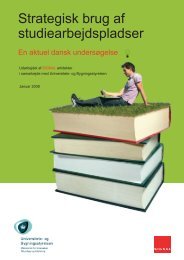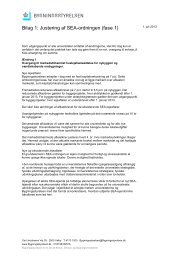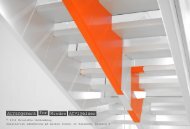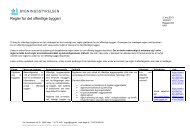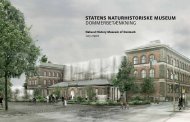Campus og studiemiljø - Bygningsstyrelsen
Campus og studiemiljø - Bygningsstyrelsen
Campus og studiemiljø - Bygningsstyrelsen
You also want an ePaper? Increase the reach of your titles
YUMPU automatically turns print PDFs into web optimized ePapers that Google loves.
easy to change between different work methods<br />
The advantage of working with a subject in different ways – by listening,<br />
acting and asking questions – is that the students remember<br />
the material better and become able to use it. Several universities<br />
therefore now try to mix different teaching methods but it can be<br />
difficult to apply different methods in the same room. It also takes<br />
time to move from lecture room to group room and back again. Technol<strong>og</strong>y<br />
helps mix the teaching methods at MIT. Students can quickly<br />
and easily change between different teaching methods, as the lecture<br />
room has been done away with and the students sit at round tables<br />
and work in groups. The teacher can walk around and supervise or<br />
display examples of group work on large screens on the walls. Presentations,<br />
group work and summing up for the more than 100 students<br />
can easily succeed one another in the same room.<br />
new role for the teacher<br />
The teacher is more of a supervisor in the technol<strong>og</strong>y-supported learning<br />
environment than in the traditional lecture room. The teacher’s<br />
desk has perhaps been replaced by the mixer desk since subjectspecific<br />
knowledge is available at a click of the mouse. It is the responsibility<br />
of the teacher to place all the bits of information in a context.<br />
Whereas in the past, the students had fixed seats in the classrooms,<br />
both students and teacher can now move around. The teacher can<br />
therefore mingle with the students and help them navigate and find<br />
information, create hypotheses and test them. Whereas, in the past,<br />
the classrooms were hierarchically structured, today’s classroom allows<br />
collaboration between the students and the teacher. The teacher<br />
and the students stand at the electronic board when exploring an issue<br />
t<strong>og</strong>ether to develop their own – and preferably brand new – solutions.<br />
In that way, technol<strong>og</strong>y and the newly fitted rooms create an optimum<br />
framework for problem-orientated teaching. The teaching is<br />
based on the knowledge the students already possess and constantly<br />
generate new questions that expand the students’ understanding of<br />
the material.<br />
technol<strong>og</strong>y tests understanding<br />
Technol<strong>og</strong>y can be used for different educational purposes, and the<br />
survey provides some examples. At the University of Strathclyde, the<br />
students are equipped with an electronic voice; much like a normal<br />
remote control. They can use this voice, to give quick and anonymous<br />
answers to the teacher’s questions about facts or opinions<br />
about a topic. This gives the teacher a quick overview. In this way,<br />
technol<strong>og</strong>y can be used to measure the level of the class. However,<br />
the main advantage is that the answers provide a good basis for a<br />
discussion in class. The feedback system does not affect the room in<br />
the above example, but in the future, the students could also become<br />
physically involved. Today, school pupils in Aarhus move around<br />
electronically generated maps or simulated environments as part of<br />
knowledge games. Light and images are projected up through the<br />
floor, and the floor is equipped with sensors, which react to the way<br />
the students physically move across it. The question is whether we<br />
will see the same technol<strong>og</strong>ical knowledge game environment at the<br />
university in the future.<br />
tema: ikt støttede læringsrum / tHeme: iCt-supported learning spaCes<br />
technol<strong>og</strong>y and learning as a field of knowledge<br />
To develop learning, rooms and technol<strong>og</strong>y is a field of knowledge<br />
in its own right. Foreign universities use virtual and physical rooms<br />
not only to improve their teaching. The teaching concepts are also a<br />
source of income for international universities and therefore given<br />
high priority in the universities’ development strategies. Collaboration<br />
between Stanford University and manufacturers of IT products<br />
results in new technol<strong>og</strong>ical products and learning environments<br />
adapted to the wishes of the university’s own teachers, which can<br />
also inspire and be purchased by others. Danish universities are well<br />
placed to contribute to this development, as Danish universities<br />
and other educational institutions have been working with different<br />
teaching and collaboration methods for a long time. To abandon<br />
lectures in favour of teaching methods that involve the students is<br />
nothing new to the Danes. The challenge is to support these new<br />
working methods with the new technol<strong>og</strong>y. The university students<br />
of the future will, however, be familiar with technol<strong>og</strong>y and different<br />
forms of learning from primary, secondary and upper secondary<br />
school.<br />
the situation in denmark<br />
The Danish ‘Folkeskole’ (primary and secondary school) has experimented<br />
with the combination of technol<strong>og</strong>y and rooms that create<br />
new possibilities for learning through movement. These experiments<br />
have not yet been introduced at the universities. It therefore<br />
remains an open question what the future integrated virtual and<br />
physical rooms will look like at university level. Perhaps technol<strong>og</strong>y<br />
will result in a more effective use of the rooms with nomadic<br />
project rooms; rooms covered with interactive boards and scanners<br />
that transmit and store data directly on the computer. Here,<br />
project groups can perhaps quickly surround themselves with<br />
mind maps, notes and outlines for assignments. The tabs on the<br />
computer screen will be displayed in the room, and after finishing,<br />
the group will switch off the equipment and leave the room for the<br />
next group to develop its own projects. Especially in science and<br />
health science subjects, rooms for computer-generated simulation<br />
could help make issues less theoretical and training more realistic.<br />
Perhaps games and role-play will no longer be limited to primary<br />
and secondary school. Perhaps virtual and physical rooms will help<br />
students assume different roles when working with learning scenarios<br />
and cases.<br />
Barriers to technol<strong>og</strong>y, rooms and learning<br />
There are different potential barriers to the development of technol<strong>og</strong>y,<br />
rooms and learning. An example of an organisational barrier<br />
could be that the technol<strong>og</strong>y strategies lack management support.<br />
Support requires more than financial prioritisation. The technol<strong>og</strong>y<br />
must be incorporated in the focus areas of the universities. One way<br />
of doing this is to harmonise teaching methods, room and technol<strong>og</strong>y<br />
the way it has been done at MIT. MIT has also created entire<br />
degree pr<strong>og</strong>rammes around technol<strong>og</strong>y-based collaboration between<br />
universities in the USA and Singapore.<br />
The technol<strong>og</strong>y has to be adapted to the planned collaboration,<br />
whether you wish to combine different university subjects and cam-<br />
199


